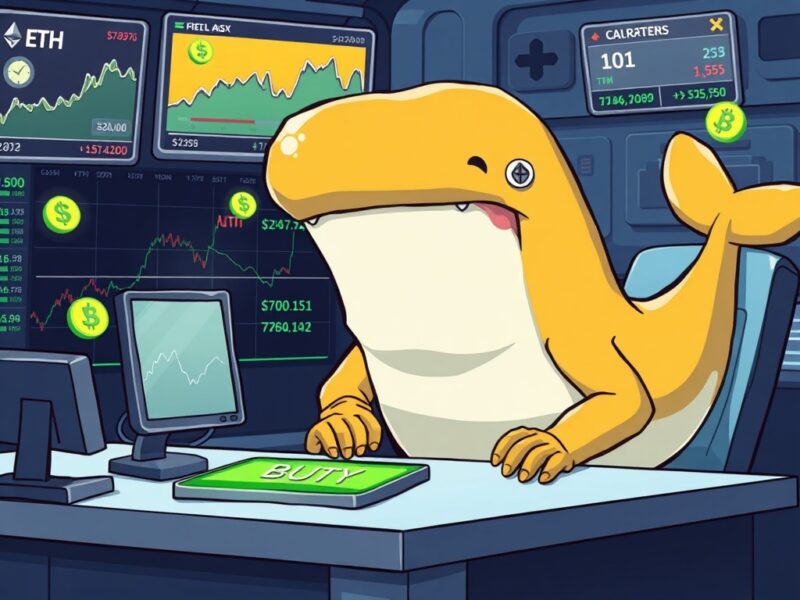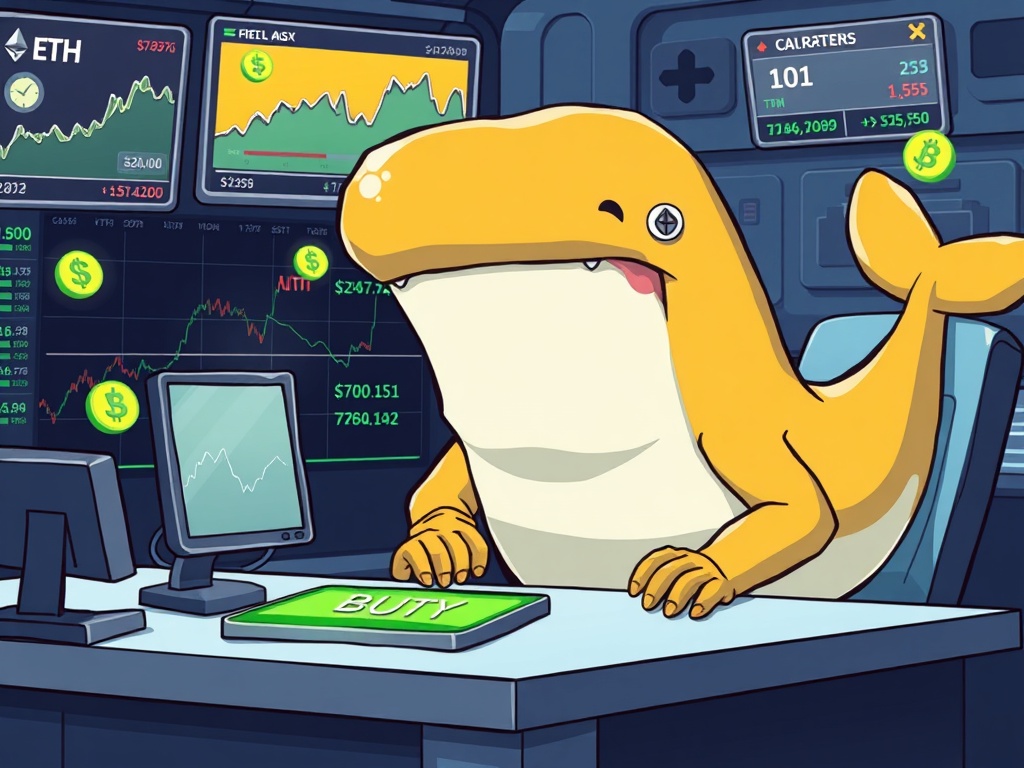ETH Long: Hyperliquid Whale’s Bold Reversal After Costly Shorts
0
0

BitcoinWorld

ETH Long: Hyperliquid Whale’s Bold Reversal After Costly Shorts
The world of cryptocurrency trading is often a high-stakes arena, and few events capture attention like a whale’s dramatic shift in strategy. Recently, a prominent Hyperliquid whale trader named AguilaTrades made headlines with a stunning reversal: after three consecutive, costly short positions on Ethereum (ETH), this influential player has now opened a massive 15x ETH long position. This bold move highlights the unpredictable nature of leveraged trading and the immense capital movements that can occur on decentralized exchanges. It’s a compelling example of how quickly fortunes can change in the crypto space.
What Just Happened in Hyperliquid Trading?
On-chain analyst @ai_9684xtpa reported on X that AguilaTrades, a significant participant on the decentralized exchange Hyperliquid, initiated a substantial 15x leveraged long position of 10,000 ETH. The entry price for this audacious trade was $4,318.12, with a calculated liquidation price of $3,851.90. This decision comes after a series of unfortunate events for the whale, who incurred total losses of approximately $3.7 million from three prior ETH short positions. This sudden pivot is a key moment in Hyperliquid trading history.
- The Pivot: From bearish shorts, incurring significant losses, to an aggressive bullish long.
- Significant Leverage: A 15x leverage amplifies both potential gains and losses dramatically.
- Substantial Capital: 10,000 ETH represents a considerable sum, making this a high-impact trade that captures market attention.
Why the Sudden Shift in Whale Crypto Strategy?
What compels a seasoned trader, even one with deep pockets, to reverse course so dramatically? While the exact motivations of AguilaTrades remain speculative, such a significant pivot often indicates a strong conviction about future price movements, or perhaps a desperate attempt to recover previous losses. A whale’s whale crypto strategy can be influenced by various factors, including evolving market sentiment, technical analysis indicators, or even unexpected news events. Understanding these underlying drivers is key.
For traders, observing these shifts is crucial for market awareness. However, it is important to remember that even large players face immense risks. High leverage, like the 15x applied here, means that even a small adverse price movement could lead to significant losses, potentially wiping out the entire position if the liquidation price is hit. This illustrates the inherent volatility in any whale crypto strategy involving high leverage.
Understanding Decentralized Exchange Dynamics
Hyperliquid is a prime example of a decentralized exchange (DEX), platforms that allow users to trade cryptocurrencies without needing a central intermediary. This decentralized nature offers several benefits compared to traditional exchanges:
- Transparency: All transactions are recorded on the blockchain, making them publicly verifiable and auditable.
- Control: Users retain full control over their funds, as assets are held in their own wallets, reducing counterparty risk.
- Accessibility: Often, DEXs are more accessible globally, with fewer KYC (Know Your Customer) requirements, though regulatory landscapes are evolving.
Whales often gravitate towards DEXs for their deep liquidity and the ability to execute large trades without significant slippage. The transparency of on-chain data also allows observers to track these large movements, providing valuable insights into potential market trends on a decentralized exchange.
The Perils and Promises of Leveraged Trading
Leveraged trading is undeniably a double-edged sword. It allows traders to control a larger position with a relatively small amount of capital, significantly amplifying potential profits. However, it equally amplifies potential losses, making it a high-risk endeavor. AguilaTrades’ recent experience with failed shorts serves as a stark reminder of this inherent risk in leveraged trading.
For individual investors, observing whale movements can be insightful, but blindly following them is perilous. Whales operate with vastly different capital bases and risk tolerances. It is essential to:
- Conduct Your Own Research: Never rely solely on the actions of others; develop your own understanding.
- Manage Risk: Implement robust risk management strategies, such as using stop-loss orders and avoiding over-leveraging your portfolio.
- Understand the Market: Stay informed about market fundamentals, technical analysis, and macroeconomic factors impacting crypto prices.
This bold maneuver by the Hyperliquid whale, transitioning from a series of losses on shorts to an aggressive ETH long, underscores the volatile and high-stakes nature of crypto markets. While the outcome of this particular trade remains to be seen, it serves as a powerful illustration of the risks and rewards associated with leveraged trading on a decentralized exchange. It reminds us that even experienced traders can face significant setbacks, and that a well-defined whale crypto strategy must always account for both potential gains and losses. Always approach the crypto market with caution and a clear understanding of your risk tolerance.
Frequently Asked Questions (FAQs)
Q1: What is a “whale trader” in cryptocurrency?
A whale trader is an individual or entity holding a very large amount of a particular cryptocurrency, enough to potentially influence its price with their trades. Their moves are closely watched by other market participants.
Q2: What does “15x leveraged long position” mean?
It means the trader is borrowing funds to amplify their position by 15 times their initial capital, betting that the asset’s price will go up. While this can magnify profits, it also significantly increases potential losses.
Q3: What is Hyperliquid?
Hyperliquid is a decentralized exchange (DEX) that allows users to trade cryptocurrencies directly from their wallets, without needing a central intermediary. It’s known for its high liquidity and on-chain transparency.
Q4: What is a “liquidation price” in leveraged trading?
The liquidation price is the point at which a leveraged position is automatically closed by the exchange to prevent further losses, typically when the market moves against the trader to a certain extent, and their collateral can no longer cover the position.
Q5: Should I follow a whale’s trading strategy?
While observing whale movements can provide market insights, it is generally not advisable to blindly follow their strategies. Whales have different capital, risk tolerance, and information access. Always conduct your own research and manage your risk.
Did this dramatic shift in crypto strategy capture your attention? Share this article with your friends and fellow crypto enthusiasts on social media to spark a conversation about whale trades and market volatility!
To learn more about the latest crypto market trends, explore our article on key developments shaping Ethereum price action.
This post ETH Long: Hyperliquid Whale’s Bold Reversal After Costly Shorts first appeared on BitcoinWorld and is written by Editorial Team
0
0
 Manage all your crypto, NFT and DeFi from one place
Manage all your crypto, NFT and DeFi from one placeSecurely connect the portfolio you’re using to start.






